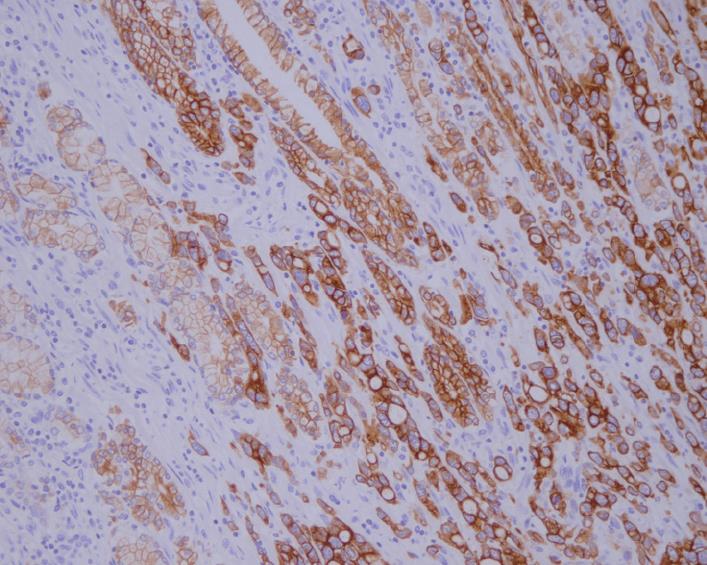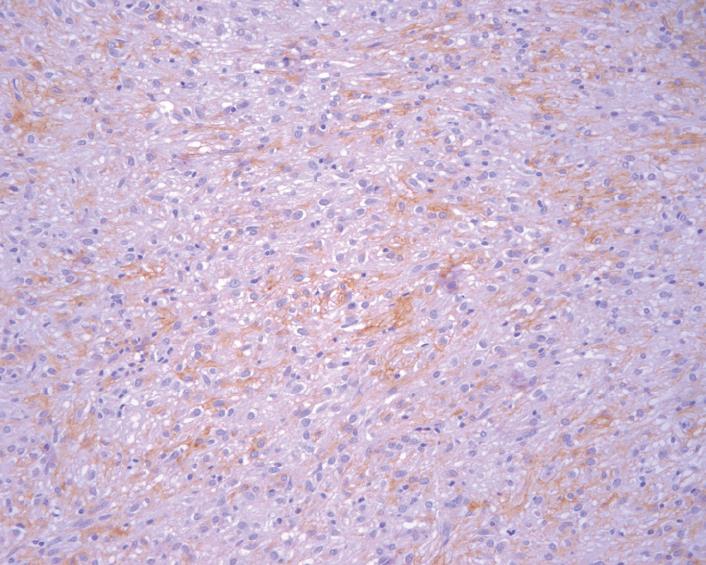INTRODUCTION
Figure 1 A diffuse type adenocarcinoma according to Lauren classification (× 20).
Figure 2 Spindle cells with low membranous positive CD117 immunostaining (× 20).
Gastrointestinal stromal tumors (GISTs) are rare neoplasms (1%) of the gastrointestinal tract[1]. It is believed that they originate from interstitial cells of Cajal (ICCs) or their precursors, which regulate gut motility. This hypothesis is based on observations that both GISTs and ICCs express the receptor tyrosine kinase KIT (c-KIT)[2]. Polymyalgia rheumatica is a clinical syndrome characterized by pain and stiffness in the neck, shoulders and hips, fatigue, weight loss and low-grade fever and rarely is presented as a paraneoplastic manifestation[3]. We report a case of synchronous occurrence of gastric adenocarcinoma and GIST in a 72-year-old female with polymyalgia rheumatica and provide a review of the literature. To the best of our knowledge this is the first case of a synchronous presentation of a gastric carcinoma and a GIST in a patient with polymyalgia rheumatica.
CASE REPORT
A 72-year-old woman was admitted to our department in September of 2007 because of epigastric pain lasting at least three months. Laboratory tests revealed elevation of the erythrocyte sedimentation rate (ESR) to 45 mm per hour and the presence of a microcytic, hypochromic anemia. All other studies were normal, except esophagogastroscopy which revealed a tumor in her stomach and a subtotal gastrectomy was performed. In the pathologic specimen of stomach, two different neoplasms were revealed: an adenocarcinoma and a GIST. The adenocarcinoma was a diffuse type according to Lauren classification (Figure 1). The gastrointestinal tumor of median diameter 1.8 cm was composed of spindle and epithelioid cells without atypia. Low mitotic activity (1/50 high powered field), low membranous CD117(KIT) positivity (Figure 2), median CD34 positivity, low positivity for smooth muscle actin (SMA) and scatter desmin positive cells were observed. Consequently, she received six cycles with the combination of cisplatin and fluorouracil (5-FU) and since April of 2008 has been disease free. From her past medical history it should be noted that she has been suffering from polymyalgia rheumatica since October of 2004, and she has been receiving corticosteroids as treatment.
DISCUSSION
GISTs are rare neoplasms and the stomach (39%-60%), small bowel (30%-42%), colon-rectum (5%-10%) and esophagus (5%) are the most common locations[4].The cell morphology is usually spindle shaped (70%), epithelioid (20%) or mixed. GISTs are immunohistochemically positive for KIT expression (90-95%) and often express BCL-2 (80%), CD34 (70%), SMA (35%), S-100 (10%) and desmin (5%)[5].
The malignancy potential of these neoplasms is highly variable and ranges from benign to malignant-aggressive tumors. Malignant proportion is about 20%-45% of all GISTs and they often lead to intra-abdominal metastases. On the contrary extra-abdominal metastases are very rare[6]. GIST size and cell proliferation rate are the most important prognostic factors. Differential diagnosis mainly includes leiomyomas and leiomyosarcomas.
They usually present as sporadic cancers but have also been reported as a familial occurrence. GISTs with extraadrenal paraganglioma and pulmonary chondroma occurred in patients with Carney’s triad[7]. They are resistant to chemotherapeutic treatment, and radiotherapy and surgery is the initial treatment, while the administration of imatinib has become standard first-line therapy for patients with unresectable or metastatic GIST. Imatinib is an inhibitor of receptor tyrosine kinases including KIT, platelet-derived growth factor receptors (PDGFRs), colony stimulating factor 1 receptor (c-FMS), breakpoint cluster region and abl gene fusion protein (BCR-ABL) and specifically blocks the adenosine-5'-triphosphate (ATP) binding site[8].
Rare cases of concurrent presentation of gastric adenocarcinoma and GIST have been reported in the literature[9,10]. Some researchers claim that their presentation is based on coincidence; meanwhile, others support the hypothesis that some unknown carcinogens provoke the simultaneous proliferation and oncogenesis of epithelial and stromal cells. Cohen et al[11] reported that exposure to both acetylsalicylic acid and nitrosoguanidine causes synchronous development of both gastric cancer and leiomyosarcoma.
The relation between polymyalgia rheumatica and giant cell arteritis is well known[3]. There is debate as to whether there is an association with the occurrence of malignancy. Case reports present a possible association of polymyalgia rheumatica with breast cancer, colon cancer and non-Hodgkin lymphoma[12-14]. On the contrary, other researchers failed to reveal a paraneoplastic mechanism[15].
A hypothesis of a relationship between glucocorticoid and gastric cancer has also been reported[16]. Kodama et al[17] reported a possible linkage between glucocorticoid excess and a malignant transformation in the epithelial cells of the esophagus. It should also be noted that systemic glucocorticoid administration is associated with skin cancers and non-Hodgkin lymphoma[18].
To the best of our knowledge this is the first case of a synchronous presentation of a gastric carcinoma and a GIST in a patient with polymyalgia rheumatica. The concomitant occurrence of these neoplasms may involve common carcinogenic factors and could be associated with polymyalgia rheumatica either through a paraneoplastic mechanism or due to its treatment with corticosteroids.










